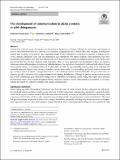Files in this item
The development of communication in alarm contexts in wild chimpanzees
Item metadata
| dc.contributor.author | Dezecache, Guillaume | |
| dc.contributor.author | Crockford, Catherine | |
| dc.contributor.author | Zuberbuhler, Klaus | |
| dc.date.accessioned | 2019-07-09T10:30:02Z | |
| dc.date.available | 2019-07-09T10:30:02Z | |
| dc.date.issued | 2019-08 | |
| dc.identifier | 259325937 | |
| dc.identifier | 7c486c42-325e-488a-b8bc-219a5d31a589 | |
| dc.identifier | 000474368300004 | |
| dc.identifier | 85068874404 | |
| dc.identifier.citation | Dezecache , G , Crockford , C & Zuberbuhler , K 2019 , ' The development of communication in alarm contexts in wild chimpanzees ' , Behavioral Ecology and Sociobiology , vol. 73 , 104 . https://doi.org/10.1007/s00265-019-2716-6 | en |
| dc.identifier.issn | 0340-5443 | |
| dc.identifier.other | ORCID: /0000-0001-8378-088X/work/64360755 | |
| dc.identifier.uri | https://hdl.handle.net/10023/18057 | |
| dc.description | Funding: The Royal Zoological Society of Scotland provided core funding to the Budongo Conservation Field Station. This research was financially supported by FP7-IDEAS-ERC (324115), the Agence Nationale de la Recherche (ANR-10-LABX-0087 IEC and ANR-10-IDEX-0001-02 PSL) and by the Swiss National Science Foundation (31003A_166458). | en |
| dc.description.abstract | Animals have evolved a range of communicative behaviours in the presence of danger. Although the mechanisms and functions of some of these behaviours have been relatively well researched, comparatively little is known about their ontogeny, including how animals learn to inform social partners about impending danger. In adult chimpanzees, behaviours in response to dangers involve several channels, particularly alarm calls and simultaneous gaze alternations with nearby recipients. Gaze alternations may allow inexperienced individuals to learn from more experienced ones by assessing their reactions to unfamiliar objects or events, but they may also provide the basis for more advanced social referencing. Here, we were interested in the development of these two common behaviours, alarm calling and gaze alternations, in wild chimpanzees (Pan troglodytes schweinfurthii) confronted with a threat. Using a cross-sectional design, we investigated those in 8 infant and 8 juveniles by experimentally exposing them to an unfamiliar but potentially dangerous object, a large, remotely controlled, moving spider model. For alarm calling, we found a positive relation with age, starting at around 28 months, although alarm calls were not consistently emitted until after 80 months. For gaze alternations, we found no age effect, with some of the youngest infants already showing the behaviour. Although its function remains unclear in infant and juvenile chimpanzees, gaze alternations emerge early in chimpanzee development. Alarm calling may require more advanced developmental stages, such as greater perceptual abilities, categorical capacities or more sophisticated social cognition, i.e. an understanding that danger is a collective experience that requires communication. | |
| dc.format.extent | 9 | |
| dc.format.extent | 1284288 | |
| dc.language.iso | eng | |
| dc.relation.ispartof | Behavioral Ecology and Sociobiology | en |
| dc.subject | Social learning | en |
| dc.subject | Social cognition | en |
| dc.subject | Alarm calling | en |
| dc.subject | Gaze | en |
| dc.subject | Pan troglodytes | en |
| dc.subject | BF Psychology | en |
| dc.subject | QH301 Biology | en |
| dc.subject | RC0321 Neuroscience. Biological psychiatry. Neuropsychiatry | en |
| dc.subject | DAS | en |
| dc.subject.lcc | BF | en |
| dc.subject.lcc | QH301 | en |
| dc.subject.lcc | RC0321 | en |
| dc.title | The development of communication in alarm contexts in wild chimpanzees | en |
| dc.type | Journal article | en |
| dc.contributor.institution | University of St Andrews. Institute of Behavioural and Neural Sciences | en |
| dc.contributor.institution | University of St Andrews. Centre for Social Learning & Cognitive Evolution | en |
| dc.contributor.institution | University of St Andrews. School of Psychology and Neuroscience | en |
| dc.identifier.doi | https://doi.org/10.1007/s00265-019-2716-6 | |
| dc.description.status | Peer reviewed | en |
This item appears in the following Collection(s)
Items in the St Andrews Research Repository are protected by copyright, with all rights reserved, unless otherwise indicated.

